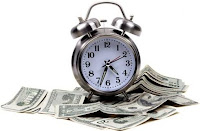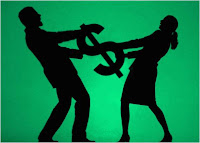 The connection between metrics and peformance is well established. The old axiom "what gets measured gets done" is true. What is less clear is whether most firms are tracking the best performance indicators.
The connection between metrics and peformance is well established. The old axiom "what gets measured gets done" is true. What is less clear is whether most firms are tracking the best performance indicators.Monday, December 22, 2008
Are You Measuring the Things That Really Matter?
 The connection between metrics and peformance is well established. The old axiom "what gets measured gets done" is true. What is less clear is whether most firms are tracking the best performance indicators.
The connection between metrics and peformance is well established. The old axiom "what gets measured gets done" is true. What is less clear is whether most firms are tracking the best performance indicators.The Myth of Multitasking
 Now here's a novel resolution for 2009--do less! Sound preposterous? Generally we charge into the new year with visions of achieving more than we did last year. Getting better results usually translates into doing more. In a weak economy, just holding your own may require working harder than last year.
Now here's a novel resolution for 2009--do less! Sound preposterous? Generally we charge into the new year with visions of achieving more than we did last year. Getting better results usually translates into doing more. In a weak economy, just holding your own may require working harder than last year.Tuesday, December 16, 2008
Don't Waste the Client's Time!
 In the midst of a recession, we can expect a significant increase in the number of sales calls as firms scramble to find work. Poor clients! Let's face it, most sales calls are a waste of the client's time. Here are a few of the classic time wasters:
In the midst of a recession, we can expect a significant increase in the number of sales calls as firms scramble to find work. Poor clients! Let's face it, most sales calls are a waste of the client's time. Here are a few of the classic time wasters:- Glad-to-meet-us sales calls. "I'd like to come by and introduce you to our firm. Who knows, you might discover something about us that you haven't seen in all the other firms calling on you."
- Drive-by sales calls. "I'm going to be in your area next week, so since it's convenient for me, I wonder if we could meet."
- Touching base sales calls. "It's been a while since we last met, so I thought it would be a good idea to get together again so, well, you won't forget about us."
- Something's up sales calls. "I know you haven't heard from us for a long time, but I heard the RFP is coming out soon, so I thought it's time we visit again."
Of course, we're never quite so honest in asking for the appointment. But don't you think clients get the message? The sales call is primarily for our benefit, especially now that we really need the work.
In my experience, the average sales call lasts about one hour. That's a substantial chunk of the client's day. And what does the client get in return for spending some of his or her valuable time with us? Let me challenge you to make answering that question foremost in thinking about your next sales calls. Here are some suggestions:
Bring something of value to every sales call. This is what I call your entree, a valid business reason for the client to expend precious time meeting with you. Typically this will involve sharing information or advice relevant to a pressing problem or need. Offer your entree as a basis for scheduling any sales call. Of course, this means you need to do your homework to try to identify what issues the client is facing before making the initial contact.
Make serving the client the focus of the call. Don't treat a sales call with a prospective client much differently than you would a project meeting. You're there to help. There's no need to tell the client about what you can do; demonstrate it by doing what you do best. That's the best way to sell anyway.
Ask for only 20 minutes of the client's time. I know, that's hardly enough time to accomplish much. So you have to come prepared to maximize the time. But here's the beauty of this approach: Rarely will you only be there for 20 minutes. If you're providing value, the client will encourage you to stay longer when you say, "I promised only 20 minutes of your time and that time's up. Is there anything more I can help you with?" It's a great way to show that you're sensitive about the value of the client's time
End each call by establishing the basis for the next meeting. As hard as it may be to identify your entree for the initial sales call, it can be even tougher for subsequent meetings. So a key goal for each sales call is to mutually determine why a next meeting would be beneficial. Of course, this is much easier to accomplish if you've shown that meeting with you is valuable for the client.
Many technical professionals spend too much time trying to convince the client why their firm is a better choice. By respecting the client's time, bringing something of value to every conversation, and demonstrating your commitment to serve the client, you will do more to win approval than any sales pitch can ever accomplish. So before you make that next call to the client, be sure you won't be wasting his or her time.
Thursday, December 11, 2008
Training On a Tight Budget
 Given the economy, your firm may be looking for ways to reign in overhead expenditures. Perhaps training is one of those "discretionary" items you're thinking about cutting. Let me urge you to reconsider. There are a number of ways to trim training costs without reducing professional development opportunities for your staff. Here are a few suggestions:
Given the economy, your firm may be looking for ways to reign in overhead expenditures. Perhaps training is one of those "discretionary" items you're thinking about cutting. Let me urge you to reconsider. There are a number of ways to trim training costs without reducing professional development opportunities for your staff. Here are a few suggestions:Monday, December 8, 2008
Level 5 Marketing
 Marketing in this business suffers from low expectations. I find this true even among most marketing professionals. In the midst of a recession with the worst still ahead for most A/E firms, perhaps it's time to raise the bar in terms of what we expect our marketing efforts to achieve.
Marketing in this business suffers from low expectations. I find this true even among most marketing professionals. In the midst of a recession with the worst still ahead for most A/E firms, perhaps it's time to raise the bar in terms of what we expect our marketing efforts to achieve.Level 1: We have some materials. You have a brochure, resumes, project descriptions, a website. For some firms, that's about as far as their marketing efforts have taken them. And some struggle even at Level 1. But for firms with a strong client base, sound selling skills, and little ambition to grow much, Level 1 may well suffice.
Wednesday, December 3, 2008
The Intrinsic Value of Your Network
 Recently I've run across many articles on networking. No doubt our faltering economy has much to do with the renewed interest in this topic. And rightfully so, for networking should be the centerpiece of your business development strategy, whether the economy is weak or strong.
Recently I've run across many articles on networking. No doubt our faltering economy has much to do with the renewed interest in this topic. And rightfully so, for networking should be the centerpiece of your business development strategy, whether the economy is weak or strong. Wednesday, November 19, 2008
Investment Time on the Rise?
 The average employee has 79 unbilled days a year. Surprised? That’s based on the industry median utilization of 60%, and doesn’t include vacation, holidays, or sick leave. That means the average 100-person firm has 7,900 days of unbilled time that can be applied to various corporate functions and initiatives (you can do the math to determine what’s available in your firm).
The average employee has 79 unbilled days a year. Surprised? That’s based on the industry median utilization of 60%, and doesn’t include vacation, holidays, or sick leave. That means the average 100-person firm has 7,900 days of unbilled time that can be applied to various corporate functions and initiatives (you can do the math to determine what’s available in your firm). - Eliminate nonproductive time. There is a distinct difference between nonbillable and nonproductive time, although some in our business seem to equate the two. When workload drops, redirect people's time to productive nonbillable tasks. Treat these tasks like projects, with budgets, schedules and accountability.
- Build teams to increase effectiveness. We do projects in teams because they increase productivity and collaboration. Nonbillable tasks generally warrant a team approach as well. Of course, it's important to assign an effective and committed leader to each team. Avoid the mistake of overloading current leaders with too many responsibilities; this is a time to help develop other leaders at various levels.
- Broaden involvement in business development. Since generating new work is a growing concern for most firms in this economy, redirecting nonbillable hours to this function is a likely priority. This doesn't just mean more sales activity. There are many opportunities for people at all levels of your firm to get involved: performing internet research, creating intellectual capital, networking with existing acquaintances, getting marketing resources (e.g., resumes, project descriptions, contact lists, etc.) in order.
For more advice on capitalizing on your investment time, check out my article "Investing Nonbillable Time."
Wednesday, November 12, 2008
Improving Your Win Rate
 As a performance metric, proposal win rate seems to invite its fair share of skepticism. Some question the reported industry median of 40%, claiming it's skewed and unrealistic. Indeed, part of the problem is inconsistency in how the number is derived. Many firms mix project add-ons and sole source awards into their calculation (it should include only competitive proposals). In my own informal surveys, as well as my experience working with different firms, I find that most fall short of the 40% benchmark. Twenty to thirty percent is more common.
As a performance metric, proposal win rate seems to invite its fair share of skepticism. Some question the reported industry median of 40%, claiming it's skewed and unrealistic. Indeed, part of the problem is inconsistency in how the number is derived. Many firms mix project add-ons and sole source awards into their calculation (it should include only competitive proposals). In my own informal surveys, as well as my experience working with different firms, I find that most fall short of the 40% benchmark. Twenty to thirty percent is more common.- Focus on the client, not your firm. The vast majority of proposals I've seen center on the preparer: "Look at us! Aren't we something special." I recognize that the client usually invites such self-promotion in the RFP. The selection criteria weigh heavily on qualifications and experience. Be responsive, but don't fall into that trap. Demonstrate your qualifications through superior knowledge of the client and the project. Address the client's priorities and concerns (of course, this requires that you did your homework up front). Use personal language--the word "you" is the most persuasive in the English language. Make the client the centerpiece of your proposal, not your firm.
- Make it skimmable. Do you really think client reviewers read your proposal cover to cover? I don't either. They skim, looking for the key information they need to make a decision. Unfortunately, most proposals are not easily skimmable. They require too much reading, too much effort. Put the most important messages in your proposal in skimmable form--bullets, boldface, graphics and photos, short paragraphs, etc. Study USA Today for ideas. Also, it's helpful to know how the client handles your proposal. Which sections are read first? What information is used in the initial screening process? Then construct your proposal (with custom-labeled tabbed dividers) to make it easy to navigate.
Of course, there is much more that I could say on this topic. But grasping the principles outlined above is a good start. For a more comprehensive treatment of the topic, check out my white paper Preparing Winning Proposals. And for strategies once you've made the shortlist, you might find the article "You Made the Shortlist: Now What?" helpful.
Got any other winning strategies you'd like to share? I welcome your ideas!
Monday, November 3, 2008
Management Communications in Tough Times
 Even in the best of times, management communications with staff are often problematic. I've conducted and reviewed several employee surveys and have found management-to-staff communication to be among the most commonly identified shortcomings. When a firm faces tough challenges, the need for effective communication is even more crucial. Unfortunately that's when many managers struggle most in this area.
Even in the best of times, management communications with staff are often problematic. I've conducted and reviewed several employee surveys and have found management-to-staff communication to be among the most commonly identified shortcomings. When a firm faces tough challenges, the need for effective communication is even more crucial. Unfortunately that's when many managers struggle most in this area.Experts at Experiences
Pine and his co-author Jim Gilmore award the EXPY each year to the company that they believe best delivers the "branded experience." The award dates back to 1999. It's interesting to note that A/E firms comprise two of the nine winners to date. Other winners include American Girl Place, Geek Squad, The LEGO Company, and Joie de Vivre Hotels.Interestingly, two of our Experience Stager of the Year award winners were A/E firms! In 2005 we gave the EXPY to HOK Sport Venue Event for the great work they have done in creating stadiums that fans perceive as authentic. That was for "what" they did. In 2007 we gave it to TST, Inc., of Fort Collins, CO, for "how" they do their engineering work!
TST--led by president Don Taranto and head of marketing Ed Goodman--created The Engineerium to provide an incredibly different, engaging experience around helping clients realize their dreams ("dreamscaping" they call it)...TST is the shining exemplar of experiences in the A/E industry.
You can learn more about TST's approach in the CENews article "Getting Out of the Commodity Zone." Hopefully that will help inspire you to ask the question: Where can our firm fit in the Experience Economy?
Tuesday, October 28, 2008
Getting Feedback From Clients
 The branded experience is consistent and intentional. This requires standards, process, and managed effort. I outlined one proven approach in my last post. The branded experience is also viewed as distinct and valued by the client. The only way to know what the client is thinking is to ask.
The branded experience is consistent and intentional. This requires standards, process, and managed effort. I outlined one proven approach in my last post. The branded experience is also viewed as distinct and valued by the client. The only way to know what the client is thinking is to ask.That's simple, but often ignored, advice. Most A/E firms don't regularly solicit feedback from their clients. I presume they believe they either (1) don't need to or (2) don't care to know. Of course, no one would ever admit to not caring what the client thinks. Yet surveys indicate that clients often feel like their A/E providers don't really care. In fact, PSMJ reports that two-thirds of clients who defect do so because of perceived indifference.
Client surveys also debunk the notion that we can safely assume we understand what our clients want without specifically asking. In conducting such surveys myself, as well as facilitating several "partnering" sessions, I can testify that there are commonly problems about which the A/E firm is unaware. In my mind, no firm will succeed in providing consistently great service (experiences) without a regular program of seeking client feedback.
A critical first step in understanding client expectations comes at project outset, in a process I call "service benchmarking." This involves asking the client specific questions about how you can optimize the working relationship and deliver a great experience. From this information, you define what actions are needed to meet client expectations. Then you need to periodically ask, "How are we doing? What can we do better?"
There are two primary means of collecting feedback from your clients that I suggest:
Ongoing dialogue with the client. This should be your primary method for getting feedback. It involves regular conversations with the client at intervals mutually determined during the benchmarking step, plus a final debriefing at the end of the project or major project phase. This activity is best handled by someone other than the project manager, typically the principal in charge or other senior manager. This person assumes the role of Client Advocate (see below).
Formal client survey. A standardized questionnaire is used primarily for tracking service performance trends across the company. While this is highly recommended, you should not use the formal survey as the primary means of gathering client-specific feedback. It's too impersonal for that purpose (although the Client Advocate can personally administer the survey, which makes it more personal and responsive).
The Client Advocate's Role
Many firms assume that their PMs can adequately monitor client satisfaction. But even the most diligent PMs can be sorely mistaken about their client's perception of their performance. Clients are often reluctant to voice their unhappiness to the PM, especially if the PM is perceived to be part of the problem.
That's why I advocate assigning every key client relationship a Client Advocate. Preferably this is someone who is not directly involved in the project work (except potentially in an advisory or oversight role). Otherwise they lose some of the objectivity and independence needed to function effectively as Client Advocate. This person's responsibilities include:
- Monitors client satisfaction. Keeps in touch with the client from time to time (as mutually agreed upon), checking to see that the client remains fully satisfied with the firm's performance.
- Ensures responsiveness. Acts as an in-house advocate for the client, seeing that the firm is fully responsive to client needs and expectations.
- Acts as third-party liaison. Serves as the point of contact when the client has a problem or concern that he or she prefers not to discuss with the PM.
- Conducts the periodic formal survey. Administers the formal survey and follows up to see that the firm responds to client concerns or suggestions that are uncovered in the survey.
Following are some suggestions for maximizing the success of the formal survey as part of your process for gathering client feedback:
- Define appropriate interval. Either annually or biannually is recommended. The proper frequency will be guided in part by the nature of both the project and your relationship with the client.
- Solicit the client's involvement in advance. Explain the purpose of the survey, its value to both parties, and the minimal time involved on the client's part. For long-term clients, request their ongoing participation.
- Distribute the questionnaire electronically. Doing the survey in person or over the phone obviously has advantages. But I'm assuming your Client Advocate has already been talking to the client. The formal survey serves a different purpose and is more easily distributed by email--either as an attachment or with a link to a secure web site (Zoomerang.com is an excellent resource). Filling out the survey should be hassle free, requiring no more than about 10 minutes of the client's time.
- Contact non-responders. Request responses within a week, then have the Client Advocate call or email to ask if the client received the survey (a not-so-subtle but friendly reminder). This will significantly improve your response rate. Remember, you've already had the client agree to participate.
- Address problems promptly. When client concerns or complaints are uncovered (and undoubtedly this will happen from time to time), you need to respond promptly and appropriately. In fact, you should define the process for addressing client concerns before sending out the survey.
- Share the results with your clients. A great way to demonstrate your commitment to great client service is to send a summary of the survey results to those clients who participated. Include in that summary the actions your firm plans to take to improve service.
How to Get Started
This best feedback will come from clients who are: (1) convinced that your firm is indeed committed to client service improvement and (2) are willing to actively help your firm improve. These are clients who recognize the value of a strong working relationship and are willing to invest a little of their time in making it happen. Don't expect all your clients to participate. But take steps to engage those who will.
- Start with your best clients. The best way to generate momentum for this process is to start with those clients who have a mutual interest in strengthening the working relationship. Pick an easily manageable number of clients to start, where you're confident you can be fully responsive to whatever feedback you receive. Then expand to other clients when you're ready.
- Build accountability into the process. Make sure your Client Advocates are fulfilling their roles, keeping in touch with the client, promptly responding to any client concerns, and seeing that the project team is meeting expectations. Anything less and the process will quickly lose credibility with both your clients and your employees.
- Communicate client feedback to the staff. Everyone in your firm should be engaged in continually improving service and striving to deliver the branded experience. Feedback from clients is the fuel that keeps the fires of continuous improvement burning. Give all employees a stake in helping your firm become a service leader. Share feedback, lessons learned, and success stories.
Wednesday, October 15, 2008
The Experience Trumps Expertise
 If Starbucks can transform a commodity like coffee into a high-end product, can we not do the same with our services? Does the Experience Economy apply to the A/E business? Let's consider the evidence.
If Starbucks can transform a commodity like coffee into a high-end product, can we not do the same with our services? Does the Experience Economy apply to the A/E business? Let's consider the evidence.As reported in their book Clientship, authors Kennedy and Greenberg asked over 500 A/E firm clients this question: "If you consider that we provide you value in two ways and that together they equal 100%, how would you divide up the value between our technical skills (what we do) and our client-service skills (how we do it)?" The prevailing response was 50/50. In other words, the experience is every bit as valuable to clients as the expertise. Other surveys in our industry have come to similar conclusions.
If you're inclined to think this overstates the value of the experience, consider this: When your firm has lost clients, was it because of technical shortcomings or inadequate service? When I've asked that question of principals and managers in our business, they overwhelmingly agree that it's service-related problems 70 to 80% of the time. So we get it. Right?
Not so fast, my friend. Another survey asked firms to identify their primary competitive advantage. Eighty percent said it was their technical capability; only 20% said it was how they served clients. We clearly place more emphasis on technical excellence than on service excellence (i.e., the client experience). That bias is evident in our business development strategies, our proposals, and our marketing materials. It's evident in the disproportionate amount of time and money we invest in technical improvement versus service improvement.
This suggests that our priorities are out of step with those of our clients. There's a substantial gap between what our clients say they value and what we think they value. I call that the Value Gap, it it represents an exciting opportunity to distinguish your firm. Indeed, I believe that closing that gap is the best differentiation strategy available to most A/E firms.
So where do you begin? That's the subject of upcoming posts. Next up: The prized product of the Experience Economy is what is commonly referred to as the branded experience. What is it and how do you create it? Stay tuned.
Tuesday, October 7, 2008
Three Value-Adding Strategies
 to value creation be a root cause of our inability to measure up to other professions? (See these earlier posts: "What's Wrong With This Picture?" and "Diagnosing the Gap") So what do we mean by value? A good working definition is: Value is the perceived benefit received minus the associated cost. Added value, then, is when one receives more benefit for the cost than was expected.
to value creation be a root cause of our inability to measure up to other professions? (See these earlier posts: "What's Wrong With This Picture?" and "Diagnosing the Gap") So what do we mean by value? A good working definition is: Value is the perceived benefit received minus the associated cost. Added value, then, is when one receives more benefit for the cost than was expected.There are a couple of important points to take from these definitions:
- Value is a personal and subjective concept that exists in the customer's mind (if you need proof, consider the crazy things that sell for a premium on Ebay!). Value cannot be accurately quantified monetarily (although purchase price is one measure). Nor can we presume what our client values; we must uncover it.
- Since value exists in the mind, it is delivered in both tangible and intangible forms. But ultimately it is always experienced in the mind. This is a hard concept for many technical professionals to grasp. We often consider technical excellence our most valuable "product." Yet just as excellent food in a restaurant with poor service equals low value, so it is with a solid project delivered with seeming indifference by the A/E provider.
With these concepts in mind, let's consider what my research suggests are the three most common value-adding strategies. These are not specific to our industry, but they are certainly all relevant to us.
Satisfy unmet or emerging needs. This is the classic sweet spot in the product/service life cycle. When you are among few firms that can meet a client's need, the solution you deliver is of high value. Yet supply and demand are only part of the value equation. One study of professional firms found that the less the client understands the problem, the more valuable the solution. Getting involved early in helping clients solve emerging, unfamiliar problems is a clear opportunity to provide higher value (hence reap higher profits and greater loyalty).
Among the three value-adding strategies, this is easily the one most commonly pursued by A/E firms. No doubt your firm has periodically added new services to address emerging markets less populated by your competitors. Unfortunately, this strategy is typically short-lived. As the need becomes better known, more firms move to meet it. With more choices of providers, the perceived value (and profit) declines. A/E firms are also routinely slow to respond to emerging opportunities. By the time most invest in new services, their competitors usually already know about it and are doing the same.
Meet clients' strategic needs. Strategic needs are those that affect the overall success of the client's organization. They commonly relate to financial, competitive, political, or operational factors. Given the critical nature of strategic needs, clients are usually willing to pay a premium for good solutions. That's one reason, I'm convinced, why other professional firms demand higher multipliers than we do--they meet strategic needs.
A/E firms once played a much larger role in this arena, but we have forfeited many of the high value, strategic services to other professionals like management consulting and accounting firms (even banks in some cases!). The role of "trusted advisor" is at the heart of meeting strategic needs. Many A/E firms find themselves merely filling orders for design services rather than helping clients define their needs and choose the optimum course of action. We are often focused to a fault on doing what we do best, unable to connect our work to the strategic needs that drive our projects
Provide distinct, valued customer experiences. This is the fundamental asset at the core of what is commonly called the Experience Economy. Businesses that command the highest profits these days usually have tapped into the Experience Economy. Consider the entertainment industry (including spectator sports), theme parks, adventure travel. Consider how the "Starbucks Experience" multiplied the value of a commodity like coffee. A five-star restaurant, as I mentioned earlier, is defined as much by its ambiance and service as by its food.
Among the three value-adding strategies, in my opinion, this one holds the greatest promise for our industry. While A/E firms routinely claim to provide "great service" (i.e., a great client experience), rare is the firm that has embraced this strategy as a management priority. In subsequent posts, I will outline why there is so much potential for adding value through superior service and what is required to ascend to the ranks of the truly differentiated.
Thursday, October 2, 2008
Responding to the Financial Crisis
 The languishing economy took a frightening turn last week with the implosion of the financial markets. As Congress scrambles to pass a rescue bill, many economists are predicting that the worst is yet to come. For most of us, this is the greatest economic uncertainty we have faced in our lifetimes.
The languishing economy took a frightening turn last week with the implosion of the financial markets. As Congress scrambles to pass a rescue bill, many economists are predicting that the worst is yet to come. For most of us, this is the greatest economic uncertainty we have faced in our lifetimes.- Stay close to your clients. Keep informed about how the crisis is affecting them. Look for opportunities to help, even if it involves meeting needs outside your normal scope of services. Subcontract additional expertise if you need it, or make referrals. The point is to make yourself as indispensable as possible. Become the trusted advisor. And, of course, make sure you keep service levels high.
- Reactivate your network. Relationships are critical in uncertain times. If you're like most who have neglected their network, this is a good time to renew your commitment to keeping in touch. Make serving others the primary objective in reconnecting. Offer information, advice, referrals--simple encouragement may suffice! Networking has always been a key growth strategy. Now it may serve as your safety net.
- Keep communication flowing with employees. Undoubtedly recent events have increased anxiety in your organization, especially if your business isn't doing particularly well. It's important to keep employees informed, or better still, engage them in helping address the emerging challenges. Organize brainstorming sessions to come up with ideas to increase service, improve efficiency, explore new opportunities. Transparency is always recommended, but don't overwhelm with bad news. Spend more time talking about the positive changes the company is undertaking.
- Step up business development efforts. If you're cutting costs, don't start here, as many firms are prone to do. Most companies have much room for improvement in how they develop new business. The current economic climate can provide the needed incentive to finally make some real headway. This is a good time to better organize your sales effort. For advice on how to do this, check out this previous post.
- Be diligent in managing cash flow. Poor collections have been a persistent problem in our industry, with receivables averaging over 70 days. Add to that the failure to get invoices out in a timely fashion. Consequently, many firms are forced to borrow to make payroll at times. Such loans may become more difficult to obtain. So now is the time to improve your firm's cash flow management. Obviously, many clients are also facing financial challenges, so collections will be more problematic for some. That's all the more reason to get serious about it.
None of these suggestions are novel. You've heard them before. The point is that uncertain times call for getting back to those things you can count on. Has your firm been neglecting any of the above? This would be a good time build on the good business practice foundations that will help your firm weather the storm that appears to be brewing on the horizon (or may have already arrived for your business).
Friday, September 26, 2008
Diagnosing the Gap

Lack of differentiation. Fundamentally, it's the problem of the undifferentiated product. When clients have more options and see fewer differences between providers, commoditization inevitably sets in. It's a buyers market; they have the leverage and usually exercise it. And providers wind up feeling less appreciated. This trend is a natural phase in the product/service life cycle.
But what about other professionals? Aren't they subject to the same laws of supply and demand? Yes, they are. And other professions are complaining about many of the same challenges that we are facing. But they also have a few advantages that we don't (as I'll explain below).
Charging by the hour. Another factor that has contributed to this problem is our historic tendency to charge by the hour rather than on the basis of the value delivered. No doubt what we do is vitally important to society. But when we sell solutions in hourly increments it invites clients to try to squeeze out the same results (or adequate results) in fewer hours. True, we're moving increasingly to lump sum contracts, but the old stigma remains.
Greater willingness to negotiate price. Other professionals also seem less prone to negotiate down their price. Undoubtedly one reason we're feeling increased pricing pressure is that clients have learned how quickly many firms cave when asked to lower prices. Many A/E firm principals believe this practice is unavoidable if they want the work. But the best way to address client cost concerns is to negotiate scope, not price. Price establishes a sense of value. If we're willing to lower prices it suggests that we're not convinced our value matches the asking price.Failure to adequately address strategic needs. One big advantage that many professionals have over us is that they help clients address their strategic needs. We tend to focus almost exclusively on technical needs. Strategic needs are those that affect the overall success of the client organization. They commonly relate to financial, competitive, political, or operational factors. Of course, our projects help meet strategic needs. But we often fail to make the connection. As a result, other professional firms have taken over some of the big-think, planning-oriented strategic roles that A/E firms used to fill.
Tuesday, September 23, 2008
What's Wrong With This Picture?
 Architecture and engineering are among the most respected professions. But they are not among the most valued. Why would I say that? Consider the following evidence:
Architecture and engineering are among the most respected professions. But they are not among the most valued. Why would I say that? Consider the following evidence:- A/E firms have a labor multiplier well below that of other professional firms, such as attorneys, accountants, management consultants, and advertising agencies. The median in our industry is 3.0 compared to 5.0 for other professionals. The mark-up on labor costs is certainly one measure of perceived value.
- Not surprisingly, A/E firms are among the least profitable of all professional service sectors. According to BizStats.com, only employment services and travel arrangement and reservation services have lower profit rates. Even administrative support services have higher profits!
- Price competitions obviously contribute to lower profits. One survey found that 68% of A/E firms had participated in procurements where cost was the primary selection criterion. Imagine what it might be if we didn't have Qualifications-Based Selection rules in place.
- Our clients are also less loyal than in other professions. A study by RainToday.com found that 88% of A/E firm clients were open to changing their current providers, the highest percentage among the professional service sectors they investigated.
- Several client surveys concur that clients see little real differentiation among firms in our industry.
These facts lend credibility to the growing sense among us that our business is becoming increasingly commoditized. This was a pervasive concern even before the economic downturn. In an environment of tighter funding and more scrutinized spending, we can expect to have to work even harder to deliver distinctive value.
Why are our services less valued than those of other professions? I don't have any ready answers, but I do have some reasonable theories. In subsequent posts, I plan to outline what I believe to be at least a big part of the problem, and what we can do about it. I hope you will contribute to the discussion.
Monday, September 22, 2008
Calibrating the Sales Process
This seemed the breakthrough I had been waiting for. I had pursued this client, located in the small town where I lived, for years. Yet we had only secured a couple of small contracts. I called a couple of experts in our firm and invited them to come to Colorado to meet with the client. I was about to learn another painful lesson about the need to understand where the client is in the decision process.
My biggest mistake was failing to account for the other decision makers involved (what's known as the "complex sale"). My contact had done his homework and come to the conclusion that outsourcing was the way to go. So our team came prepared to talk about how that transaction would take place. Besides my contact, we would be meeting with the facility manager, engineering manager, and wastewater treatment plant operator.
Research suggests that people go through five stages in making a purchase decision (or most any kind of decision). These are:
- Recognize a problem or need
- Search for information about both the need and possible solutions
- Evaluate the possible alternatives
- Make a decision (or purchase)
- Assess the decision (post-purchase evaluation)
In sales, it's important to recognize where in this process the client is and align your approach accordingly. In the complex sale, of course, different buyers can be (and often are) in different stages of the decision process.
You can guess where the story goes. The environmental manager was ready to make a decision, and we had come prepared to help him. The facility manager, however, was still searching for information, aware that there were problems but not sure what to make of them. The engineering manager was a little farther along, considering various alternatives, one being outsourcing. But he was leaning against that option. Finally, the operator was incredulous. "What's the problem?" he wanted to know.
It was a rancorous meeting, one we were hardly prepared to moderate. The outsourcing opportunity never materialized, nor did any other contracts with this client. My contact, the environmental manager, left the company shortly after to become a consultant. Maybe he thought he could do a better job than we had that day!
In my experience, not many technical consulting and design firms excel in managing the complex sale. It takes time and can be difficult at times. That's all the more reason to give it priority. Understanding the players involved enables you to calibrate your sales approach to respond to their concerns and goals, as well as to where they are in the decision process.
Thursday, September 18, 2008
Well, Duh!
 Sometimes we fail to do the obvious things that would improve our chances of success. I'm certainly guilty of that. How about you? Maybe we haven't had the "Aha!" moment when it suddenly becomes clear what we should have been doing all along. Other times the better way is staring us in the face and we still don't act on it for whatever reason.
Sometimes we fail to do the obvious things that would improve our chances of success. I'm certainly guilty of that. How about you? Maybe we haven't had the "Aha!" moment when it suddenly becomes clear what we should have been doing all along. Other times the better way is staring us in the face and we still don't act on it for whatever reason.I was reminded of this yesterday as I delivered a couple of sessions at the Virginia Engineers Conference. One dealt with time management, the other was on persuasive communication. As I often do, I occasionally asked for a show of hands to see how many people or firms were doing the things I recommended. These included:
- Planning one's activities for the week. Only about a third of my audience indicated that they took a little time at the start of the week to identify priorities and schedule activities. No wonder so many find themselves in the throes of "fighting fires" day in and day out. Stephen Covey's research found that the average corporation spends about 75-90% percent of its time on urgent activities, most of which are not considered important.
- Managing non-billable time. Less than a fourth of attendees indicated that their companies "manage" the non-billable hours spent on activities such as business development or corporate initiatives. By manage, I mean determining the level of effort required, assigning people specific tasks, budgeting their time, and tracking how much time is actually spent. Billable hours, of course, receive this kind of attention. Why not the "investment time" critical to a firm's success?
- Making documents skimmable. While everyone seemed to agree that their proposals and reports were probably skimmed rather than read by their target audiences, no one indicated that their firm designed documents to make them more skimmable! This is an obvious opportunity to set our proposals apart. Using second person in proposals. Once again, no one raised their hand when I asked how many used the word "you" in their proposals (this was an audience of about 75 people!). This despite the fact that several studies over the last 30 years have reached the same conclusion: You is the most persuasive word in the English language. Why then is it banished from our most important persuasive documents?
- Including an executive summary in proposals. Very few indicated they did this, something that I've routinely done for many years. I recognize that RFPs rarely ask for one, so the obviousness of this strategy may not seem apparent. But one large study found that executives read 100% of summaries in reports and similar documents (that's why they're called "executive summaries"), while only 10% read the body of the documents. Does this apply to proposals? I can't prove it, but will point to my 75% win rate as evidence that it at least seems to work.
- Regularly soliciting feedback from clients. Everyone claims to provide great service to their clients, but only about a fourth of firms routinely ask clients how well they're doing, based on my informal survey. A major study by Accenture of service leaders across different industries found that they consistently do two things: (1) relentlessly manage the service delivery process (something rarely done in our industry!) and (2) routinely solicit feedback from customers.
There are undoubtedly many other obvious things we should be doing; these are just a few that came up in my presentations yesterday. It might be fun to compile a "Well, duh!" list of strategies that are inexplicably ignored in our business. Any you'd like to contribute?

